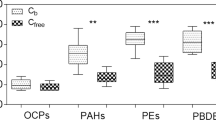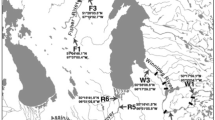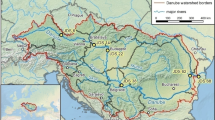Abstract
Background, aim, and scope
The potential of wetlands for controlling point- and nonpoint-source pollution in surface water has attracted increasing interest. The partitioning process of organic contaminants between water, particulate organic carbon (POC) and dissolved organic carbon (DOC), impacts their behaviors in the aquatic environments. Meantime, the partitioning process of organic contaminants is closely related to their physicochemical properties, such as hydrophobicity (or K ow), and their fates in wetlands may vary greatly depending on physicochemical properties. The aim of this study was to examine fates and removals of polycyclic aromatic hydrocarbons (PAHs), organochlorine pesticides (OCPs) and nonylphenols (NPs) in a wetland in Bei**g, China, and provide useful information for ecological remediation.
Materials and methods
Water samples, collected at five sites from inlet to outlet of the wetland once a month in summer 2006, were immediately filtered within 2 days through 0.45-μm glass fiber prefilters and enriched by solid-phase extraction. The filtered particulates were collected as the total suspended particulates (TSPs), freeze-dried, and Soxhlet-extracted. After extraction, samples were purified following a clean-up procedure and analyzed by GC-MS.
Results
TSPs could be removed efficiently with a removal rate of 97.4%, and DOC could be moderately removed with a removal rate of 44.7% from inlet to outlet. The total removals of target contaminants varied widely from null to 82.0%. A good correlation between logK ow and logK oc (organic-carbon-normalized suspended-particulate partition coefficient) was observed (r 2 = 0.84 for PAHs and r 2 = 0.86 for OCPs, p < 0.01). Ratios of the POC-bound fraction of target contaminants (or DOC-bound fraction) to the freely dissolved fraction increased with their K ow values. The removal of the POC fraction contributed more than 50% to the total removal for the contaminants with logK ow > 5.0. Only a small portion of the removal was attributed to the removal of the freely dissolved fraction.
Discussion
Hydrophobic compounds such as PAHs and OCPs with higher K ow values would show stronger POC or DOC preference. Their removal depended greatly on their K ow values and the removal of total suspended particulates. On the other hand, concentrations of NPs decreased little in the wetland, probably due to their production through degradation of their precursors and relatively low hydrophobicity.
Conclusions
POC and DOC play essential roles on the fates and removals of hydrophobic organic contaminants in the wetland. The removal of target contaminants with a high K ow should be mainly through association with the suspended particulates which were precipitated and retained in the wetland. The fates of the organic contaminants in the wetland greatly depended on their hydrophobicities.
Recommendations and perspectives
Further work should be done to study the influence of hydraulic retention time and some other environmental factors, e.g., temperature, on removals and fates of organic contaminants. Behavior of NPs and their precursors in the wetland should also be investigated more thoroughly.

Similar content being viewed by others
References
Ahel M, Giger W, Schaffner C (1994) Behavior of alkylphenol polyethoxylate surfactants in the aquatic environment. 2. Occurrence and transformation in rivers. Water Res 28:1143–1152
Belmont M, Metcalfe C (2003) Feasibility of using ornamental plants (Zantedeschia aethiopica) in subsurface flow treatment wetlands to remove nitrogen, chemical oxygen demand and nonylphenol ethoxylate surfactants—a laboratory-scale study. Ecol Eng 21:233–247
Bezbaruah A, Zhang T (2003) Performance of a constructed wetland with a sulfur/limestone denitrification section for wastewater nitrogen removal. Environ Sci Technol 37:1690–1697
Burkhard L (2000) Estimating dissolved organic carbon partition coefficients for nonionic organic chemicals. Environ Sci Technol 34:4663–4668
Chin Y, Gschwend P (1992) Partitioning of polycyclic aromatic hydrocarbons to marine porewater organic colloids. Environ Sci Technol 26:1621–1626
Chiou C, McGroddy S, Kile D (1998) Partition characteristics of polycyclic aromatic hydrocarbons on soils and sediments. Environ Sci Technol 32:264–269
Chu W, Chan K (2000) The prediction of partitioning coefficients for chemicals causing environmental concern. Sci Tot Environ 248:1–10
Gross B, Montgomery-Brown J, Naumann A, Reinhard M (2004) Occurrence and fate of pharmaceuticals and alkylphenol ethoxylate metabolites in an effluent-dominated river and wetland. Environ Toxicol Chem 23:2074–2083
Gschwend P, Wu S (1984) On the constancy of sediment-water partition coefficients of hydrophobic organic pollutants. Environ Sci Technol 19:90–96
Huang S, Wang Z, Xu Y, Ma M (2005) Distribution, sources and potential toxicological significance of polycyclic aromatic hydrocarbons (PAHs) in Guanting Reservoir sediments, China. J Environ Sci 17:48–53
Jonker M, Smedes F (2000) Preferential sorption of planar contaminants in sediments from Lake Ketelmeer, the Netherlands. Environ Sci Technol 34:1620–1626
Karickhoff S (1981) Semi-empirical estimation of sorption of hydrophobic pollutants on natural sediments and soils. Chemosphere 10:833–846
Lewis M, Mayer F, Powell R, Nelson M, Klaine S, Henry M, Dickson G (1999) Ecotoxicology and risk assessment for wetlands. Society of Environmental Toxicology and Chemistry (SETAC), Pensacola, FL, pp 315–342
Mackay D, Shiu W, Ma K (1992) Illustrated handbook of physical-chemical properties and environmental fate for organic compounds. Lewis, Boca Raton, FL, USA
Matamoros V, Bayona J (2006) Elimination of pharmaceuticals and personal care products in subsurface flow constructed wetlands. Environ Sci Technol 40:5811–5816
Matamoros V, García J, Bayona J (2005) Behavior of selected pharmaceuticals in subsurface flow constructed wetlands: a pilot-scale study. Environ Sci Technol 39:5449–5454
Matamoros V, Arias C, Brix H, Bayona J (2007) Removal of pharmaceuticals and personal care products (PPCPs) from urban wastewater in a pilot vertical flow constructed wetland and a sand filter. Environ Sci Technol 41:8171–8177
Matamoros V, García J, Bayona J (2008) Organic micropollutant removal in a full-scale surface flow constructed wetland fed with secondary effluent. Water Res 42:653–660
Mitra S, Dickhut R (1999) Three-phase modeling of polycyclic aromatic hydrocarbon association with pore-water-dissolved organic carbon. Environ Toxicol Chem 18:1144–1148
Qiao P, Farrell A (2002) Influence of dissolved humic acid on hydrophobic chemical uptake in juvenile rainbow trout. Comp Biochem Physiol C 133:575–585
Qiao M, Wang C, Huang S, Wang D, Wang Z (2006) Composition, sources, and potential toxicological significance of PAHs in the surface sediments of the Meiliang Bay, Taihu Lake, China. Environ Int 32:28–33
Qiao M, Huang S, Wang Z (2008) Partitioning characteristics of PAHs between sediment and water in a shallow lake. J Soils Sediments 8(2):69–73
Rose M, Sanchez-Bayo F, Crossan A, Kennedy I (2006) Pesticide removal from cotton farm tailwater by a pilot-scale ponded wetland. Chemosphere 63:1849–1858
Roy F, Weston Inc (1990) Determination of the vapor pressure of 4-nonylphenol. Final Report Study No. 90-047. Roy, F., Weston Inc., Environmental Fate and Effects Laboratory, 254 Welsh Pool Road, Lionville, PA. 15 August 1990
Schulz R, Peall S (2001) Effectiveness of a constructed wetland for retention of nonpoint-source pesticide pollution in the Lourens River Catchment, South Africa. Environ Sci Technol 35:422–426
Schulz R, Hahn C, Bennett E, Dabrowski J, Peall S (2003) Fate and Effects of azinphos-methyl in a flow-through wetland in South Africa. Environ Sci Technol 37:2139–2144
Servos M, Muir D (1989) Effect of suspended sediment concentration on the sediment to water partition coefficient for 1, 3, 6, 8-tetrachtorodibenzo-p-dioxin. Environ Sci Technol 23:1302–1306
Smit M, Grotenhuis T, Bruning H, Rulkens W (2008) Desorption of dieldrin from field aged sediments: simulating flood events. J Soils Sediments 8:80–85
U.S. Environmental Protection Agency (1993) Constructed wetlands for wastewater treatment and wildlife habitat, 17 case studies (EPA832-R-93-005)
Weber J, Kreutzmann J, Plantikow A, Pfitzner A, Claus E, Manz W, Heininger P (2006) A novel particle contact assay with the yeast Saccharomyces cerevisiae for ecotoxicological assessment of freshwater sediments. J Soils Sediments 6:84–91
Xu Y, Wang Z, Ke R, Khan SU (2005) Accumulation of organochlorine pesticides from water using triolein embedded cellulose acetate membranes. Environ Sci Technol 39:1152–1157
Xue N, Zhang D, Xu X (2006) Organochlorinated pesticide multiresidues in surface sediments from Bei**g Guanting reservoir. Water Res 40:183–194
Zhou J, Maskaoui K (2003) Distribution of polycyclic aromatic hydrocarbons in water and surface sediments from Daya Bay, China. Environl Pollut 121:269–281
Zhou J, Rowland S (1997) Evaluation of the interactions between hydrophobic organic pollutants and suspended particles in estuarine waters. Water Res 31:1708–1718
Acknowledgement
This research has been funded by the Innovation Program of the Chinese Academy of Sciences (KZCX1-YW-06-02) and National Natural Science Foundation of China (40703025 and 20737003).
Author information
Authors and Affiliations
Corresponding author
Additional information
Responsible editor: Jianming Xu
Rights and permissions
About this article
Cite this article
Luo, J., Ma, M., Liu, C. et al. Impacts of particulate organic carbon and dissolved organic carbon on removal of polycyclic aromatic hydrocarbons, organochlorine pesticides, and nonylphenols in a wetland. J Soils Sediments 9, 180–187 (2009). https://doi.org/10.1007/s11368-009-0081-1
Received:
Accepted:
Published:
Issue Date:
DOI: https://doi.org/10.1007/s11368-009-0081-1




